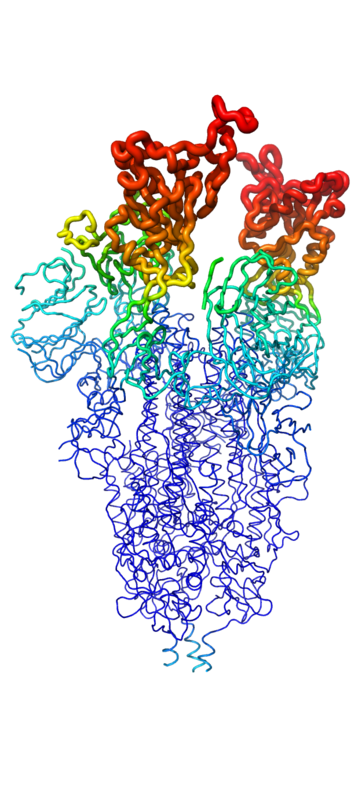Sandbox Reserved 1849
From Proteopedia
(Difference between revisions)
| Line 5: | Line 5: | ||
You may include any references to papers as in: the use of JSmol in Proteopedia <ref>DOI 10.1002/ijch.201300024</ref> or to the article describing Jmol <ref>PMID:21638687</ref> to the rescue. | You may include any references to papers as in: the use of JSmol in Proteopedia <ref>DOI 10.1002/ijch.201300024</ref> or to the article describing Jmol <ref>PMID:21638687</ref> to the rescue. | ||
==Introduction== | ==Introduction== | ||
| - | + | ||
==SARS-COV-2 Spike Protein== | ==SARS-COV-2 Spike Protein== | ||
<p>The <scene name='10/1075251/Spike_protein_closed_spacefill/2'>spike protein</scene> of SARS-COV-2 is a symmetric trimer featuring 3 spike glycoprotein chains (UNIPROT: [https://www.uniprot.org/uniprotkb/P0DTC2/entry P0DTC2]). Each monomer of the spike is called a spike glycoprotein, and the total assembly contains 2 main parts: The <scene name='10/1075251/Spike_protein_1-up_yang_s1/1'>S1</scene> and <scene name='10/1075251/Spike_protein_1-up_yang_s2/1'>S2</scene> subunits<ref name="Huang">DOI:10.1038/s41401-020-0485-4</ref>. However, the native spike protein does not exist in this state prior to infection. The protein is actually inactive initially, but is later activated by proteases cleaving the inactive S protein into its two active subunits<ref name="Huang">DOI:10.1038/s41401-020-0485-4</ref>. The S1 subunit contains the <scene name='10/1075251/Spike_protein_2-up_yang_s1_dom/1'>N-Terminal domain (NTD), C-Terminal Domain (CTD), and the Receptor Binding Domain (RBD)</scene>. The RBD is responsible for binding to the ACE2 receptor on the surface of the target cell, as well as neutralizing antibodies. The NTD, CTD, and their relevant interfaces actually play much larger roles in the binding of the spike protein to ACE2 than the RBD does due to their larger surface areas<ref name="Huang">DOI:10.1038/s41401-020-0485-4</ref>. The S2 subunit is responsible for viral fusion and entry. Once bound to ACE2, and after the different domains in S2 have anchored to the membrane as well as delivered the viral envelope, the S2 subunit then changes conformation from the pre-hairpin to postfusion-hairpin conformation<ref name="Huang">DOI:10.1038/s41401-020-0485-4</ref>. The S2 subunit contains a fusion peptide domain (FP), heptapeptide repeat sequences 1 and 2 (HR1 & HR2), TM domain, and cytoplasmic fusion domain (CT). Full information about the location and structures of these domains within the S2 subunit can be found in references 1 and 3<ref name="Huang">DOI:10.1038/s41401-020-0485-4</ref><ref name="Zhang">PMID:34534731</ref>. For the purpose of this article about the minibinders, attention will be directed to the S1 subunit and its binding properties with ACE2. | <p>The <scene name='10/1075251/Spike_protein_closed_spacefill/2'>spike protein</scene> of SARS-COV-2 is a symmetric trimer featuring 3 spike glycoprotein chains (UNIPROT: [https://www.uniprot.org/uniprotkb/P0DTC2/entry P0DTC2]). Each monomer of the spike is called a spike glycoprotein, and the total assembly contains 2 main parts: The <scene name='10/1075251/Spike_protein_1-up_yang_s1/1'>S1</scene> and <scene name='10/1075251/Spike_protein_1-up_yang_s2/1'>S2</scene> subunits<ref name="Huang">DOI:10.1038/s41401-020-0485-4</ref>. However, the native spike protein does not exist in this state prior to infection. The protein is actually inactive initially, but is later activated by proteases cleaving the inactive S protein into its two active subunits<ref name="Huang">DOI:10.1038/s41401-020-0485-4</ref>. The S1 subunit contains the <scene name='10/1075251/Spike_protein_2-up_yang_s1_dom/1'>N-Terminal domain (NTD), C-Terminal Domain (CTD), and the Receptor Binding Domain (RBD)</scene>. The RBD is responsible for binding to the ACE2 receptor on the surface of the target cell, as well as neutralizing antibodies. The NTD, CTD, and their relevant interfaces actually play much larger roles in the binding of the spike protein to ACE2 than the RBD does due to their larger surface areas<ref name="Huang">DOI:10.1038/s41401-020-0485-4</ref>. The S2 subunit is responsible for viral fusion and entry. Once bound to ACE2, and after the different domains in S2 have anchored to the membrane as well as delivered the viral envelope, the S2 subunit then changes conformation from the pre-hairpin to postfusion-hairpin conformation<ref name="Huang">DOI:10.1038/s41401-020-0485-4</ref>. The S2 subunit contains a fusion peptide domain (FP), heptapeptide repeat sequences 1 and 2 (HR1 & HR2), TM domain, and cytoplasmic fusion domain (CT). Full information about the location and structures of these domains within the S2 subunit can be found in references 1 and 3<ref name="Huang">DOI:10.1038/s41401-020-0485-4</ref><ref name="Zhang">PMID:34534731</ref>. For the purpose of this article about the minibinders, attention will be directed to the S1 subunit and its binding properties with ACE2. | ||
Revision as of 18:26, 10 April 2025
| This Sandbox is Reserved from March 18 through September 1, 2025 for use in the course CH462 Biochemistry II taught by R. Jeremy Johnson and Mark Macbeth at the Butler University, Indianapolis, USA. This reservation includes Sandbox Reserved 1828 through Sandbox Reserved 1846. |
To get started:
More help: Help:Editing |
SARS-COV2 Minibinders
| |||||||||||
References
- ↑ Hanson, R. M., Prilusky, J., Renjian, Z., Nakane, T. and Sussman, J. L. (2013), JSmol and the Next-Generation Web-Based Representation of 3D Molecular Structure as Applied to Proteopedia. Isr. J. Chem., 53:207-216. doi:http://dx.doi.org/10.1002/ijch.201300024
- ↑ Herraez A. Biomolecules in the computer: Jmol to the rescue. Biochem Mol Biol Educ. 2006 Jul;34(4):255-61. doi: 10.1002/bmb.2006.494034042644. PMID:21638687 doi:10.1002/bmb.2006.494034042644
- ↑ 3.0 3.1 3.2 3.3 3.4 3.5 3.6 Huang Y, Yang C, Xu XF, Xu W, Liu SW. Structural and functional properties of SARS-CoV-2 spike protein: potential antivirus drug development for COVID-19. Acta Pharmacol Sin. 2020 Sep;41(9):1141-1149. doi: 10.1038/s41401-020-0485-4., Epub 2020 Aug 3. PMID:32747721 doi:http://dx.doi.org/10.1038/s41401-020-0485-4
- ↑ 4.0 4.1 4.2 4.3 Zhang J, Xiao T, Cai Y, Chen B. Structure of SARS-CoV-2 spike protein. Curr Opin Virol. 2021 Oct;50:173-182. PMID:34534731 doi:10.1016/j.coviro.2021.08.010
- ↑ 5.0 5.1 5.2 Yuan Y, Cao D, Zhang Y, Ma J, Qi J, Wang Q, Lu G, Wu Y, Yan J, Shi Y, Zhang X, Gao GF. Cryo-EM structures of MERS-CoV and SARS-CoV spike glycoproteins reveal the dynamic receptor binding domains. Nat Commun. 2017 Apr 10;8:15092. doi: 10.1038/ncomms15092. PMID:28393837 doi:http://dx.doi.org/10.1038/ncomms15092
- ↑ 6.0 6.1 6.2 Kuba K, Yamaguchi T, Penninger JM. Angiotensin-Converting Enzyme 2 (ACE2) in the Pathogenesis of ARDS in COVID-19. Front Immunol. 2021 Dec 22;12:732690. PMID:35003058 doi:10.3389/fimmu.2021.732690
- ↑ 7.0 7.1 Kuba K, Imai Y, Rao S, Gao H, Guo F, Guan B, Huan Y, Yang P, Zhang Y, Deng W, Bao L, Zhang B, Liu G, Wang Z, Chappell M, Liu Y, Zheng D, Leibbrandt A, Wada T, Slutsky AS, Liu D, Qin C, Jiang C, Penninger JM. A crucial role of angiotensin converting enzyme 2 (ACE2) in SARS coronavirus-induced lung injury. Nat Med. 2005 Aug;11(8):875-9. PMID:16007097 doi:10.1038/nm1267

